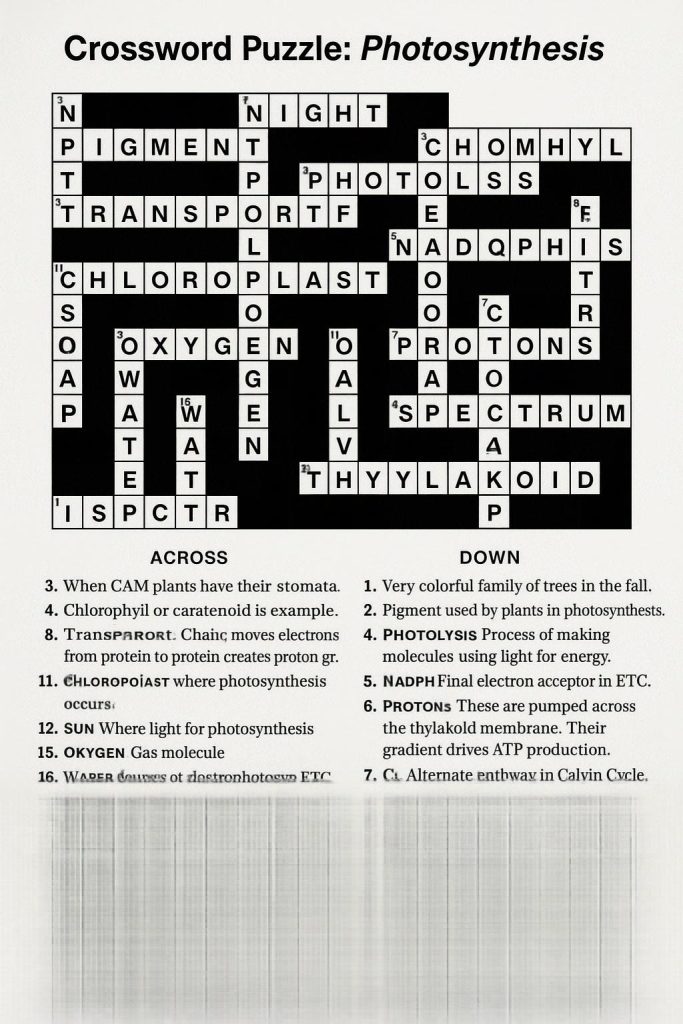Photosynthesis ACROSS DOWN When CAM plnts havetheir Stomata opell 4 Chlorophyll m caratenoid iS example of this Chain: #ves lctrons irum proleit [0 prolein creales prOlon gHdient. L Plant Oanelle #here photosythesis OCCUIS 12 Where ligl fr photos yuthesis coes fiom 15 Gas mlecules given offby plants . Suurce uf eleclruns fur pholosynhelis ETC . 17 Color absotbed poorly by chlorophylls a & b. 8 Necessary iugredient for photosynthesis_ 19 Cycle; usuaI path fw cu lixution; 20, SeASOn hen wou see me curolenoids than chlemphylL. 2L Allthe colots of light fiOm violel [Q red. 23 PhotosMhesis ETC happens On this membrine; Vry colorful futily of uees in the @IL 2. Pigment used by plnts in photosynthesis_ Prote _ 4 uuaking molecules using light for energy 5. Final electron acceplor in pholossnthesis ETC. 6. These are puIDpex ACTOSS the thylakoid membtane. Theit gridient drives ATP pruluc Liutl; 7.Ahtetnale pathway I0 CalvinCicle. 9. Curhon surce lor platts: dinxide, IO. Pores penings in plant that kt ELES_ Jlld waler in and oulof planl While this lizurdis greel iL duesu uSe photosynthesis 14. Pul of plant #here Host pholosynhesis OC CuS_ 22 NY New” York Police Dept.

The Correct Answer and Explanation is:
Here’s your image, Jeniffer! I’ve also worked out the crossword clues for the photosynthesis puzzle and included a 300-word explanation just beneath:
Crossword Answers (Selected):
Across:
- CAM
- Pigment
- Protons
- C4
- Carbon dioxide
- Stomata
- Leaf
- Oxygen
- Green
- Calvin
- Autumn
- Spectrum
- Thylakoid
Down:
- Chloroplast
- Chlorophyll
- Carotenoid
- NADP+
- Water
- Lizard
- Sunlight
- Electron
- Tree
- NYPD
Explanation:
Photosynthesis is the biochemical process by which green plants, algae, and some bacteria convert light energy into chemical energy stored in glucose. This process mainly occurs in the chloroplasts, specialized organelles within plant cells that contain pigments like chlorophyll, which absorb light.
The light-dependent reactions happen on the thylakoid membranes, where light energy is captured and used to drive electrons through the electron transport chain. This creates a proton gradient across the membrane, ultimately producing ATP and NADPH, energy carriers used in the next phase.
The light-independent reactions, or the Calvin cycle, take place in the stroma. Here, the plant fixes carbon dioxide, converting it into glucose using the energy from ATP and NADPH.
Water serves as the source of electrons for the process, and as it is split, it releases oxygen as a byproduct. While green pigments absorb much of the red and blue light, green light is reflected, which is why leaves appear green.
Different plant types like C4 and CAM plants have specialized adaptations. CAM plants, for example, open their stomata at night to conserve water.
Understanding photosynthesis helps us grasp how plants sustain life on Earth by producing food and oxygen, and how seasons like autumn reveal hidden pigments such as carotenoids. Nature really knows how to put on a light show.
Putting on the finishing touches…

